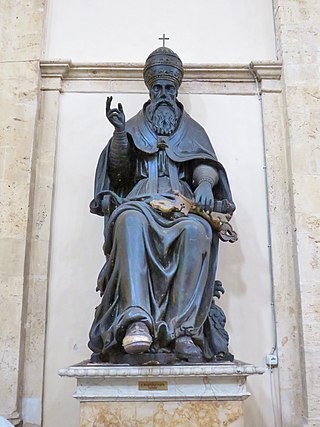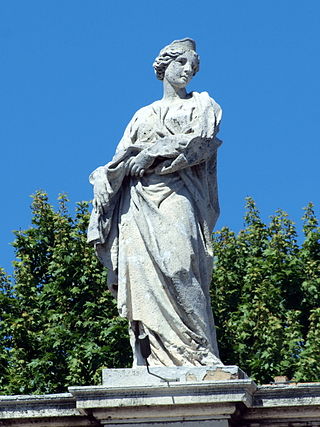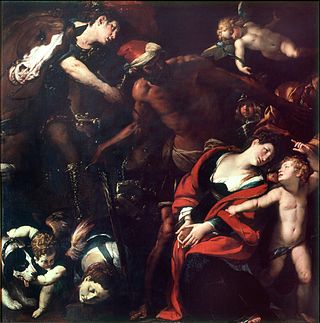
Pope Martin I, also known as Martin the Confessor, was the bishop of Rome from 21 July 649 to his death 16 September 655. He served as Pope Theodore I's ambassador to Constantinople and was elected to succeed him as Pope. He was the only pope during the Eastern Roman domination of the papacy whose election was not approved by an imperial mandate from Constantinople. For his strong opposition to Monothelitism, Pope Martin I was arrested by Emperor Constans II, carried off to Constantinople, and ultimately banished to Cherson. He is considered a saint by both the Catholic Church and the Eastern Orthodox Church and he is the last pope recognized as a martyr.

Pope Callixtus I, also called Callistus I, was the bishop of Rome from c. 218 to his death c. 222 or 223. He lived during the reigns of the Roman emperors Elagabalus and Alexander Severus. Eusebius and the Liberian catalogue list his episcopate as having lasted five years (217–222). In 217, when Callixtus followed Zephyrinus as Bishop of Rome, he started to admit into the Church converts from sects or schisms. He was martyred for his Christian faith and is venerated as a saint by the Catholic Church.

Pope Sylvester I was the bishop of Rome from 31 January 314 until his death on 31 December 335. He filled the See of Rome at an important era in the history of the Western Church, though very little is known of his life.

Saints Faith, Hope and Charity, are a group of Christian martyred saints, venerated together with their mother, Sofiia ("Wisdom").

Abdon and Sennen, variously written in early calendars and martyrologies Abdo, Abdus, and Sennes, Sennis, Zennen, are recognized by the Catholic Church and Eastern Orthodox Church as Christian martyrs, with a feast day on 30 July. In some places they have been honoured on 20 March, and the first Sunday of May.

Tegernsee Abbey is a former Benedictine monastery in the town and district of Tegernsee in Bavaria. Both the abbey and the town that grew up around it are named after the Tegernsee, the lake on the shores of which they are located. The name is from the Old High German tegarin seo, meaning great lake.
Saints Marius, Martha, Audifax, and Abachum were, according to their largely legendary passio of the 6th century, four saints of the same family. They came from Persia to Rome, and were martyred in 270 for sympathizing with Christian martyrs and burying their bodies. Some ancient martyrologies place the date of their death between 268 and 270, during the reign of Claudius II, although there was no persecution of Christians during this time.

Felix and Adauctus (d. 303) were according to tradition, Christian martyrs who were said to have suffered during the Great Persecution during the reign of the Roman emperor Diocletian.

Saints Protus and Hyacinth were Christian martyrs during the persecution of Emperor Valerian. Protus' name is sometimes spelled Protatius, Proteus, Prothus, Prote, and Proto. His name was corrupted in England as Saint Pratt. Hyacinth is sometimes called by his Latin name Hyacinthus.

Mark and Marcellian are martyrs venerated as saints by the Roman Catholic Church and the Eastern Orthodox Church. Their cult is sometimes associated with that of Saints Tranquillinus, Martia, Nicostratus, Zoe, Castulus, and Tiburtius, though not in the official liturgical books of the Church, which mention only Mark and Marcellianus among the saints for 18 June. Their mention in the General Roman Calendar on that date from before the time of the Tridentine calendar was removed in the 1969 revision, because nothing is known about them except their names, the fact of their martyrdom, and that they were buried on 18 June in the cemetery of Santa Balbina on the Via Ardeatina.

Balbina of Rome, sometimes called Saint Balbina and Balbina the Virgin is venerated as a virgin martyr and saint of the Catholic Church.

Symphorian, Timotheus (Timothy), and Hippolytus of Rome are three Christian martyrs who, though they were unrelated and were killed in different places and at different times, shared a common feast day in the General Roman Calendar from at least the 1568 Tridentine calendar to the Mysterii Paschalis. While still a young man, Symphorian was either beheaded or beaten to death with clubs.

Rufina and Secunda were Roman virgin-martyrs and Christian saints. Their feast day is celebrated on 10 July.

Nicasius, Quirinus, Scubiculus, and Pientia were venerated as martyrs and saints. Their feast day is 11 October. Their historicity is uncertain, and "no trustworthy historical reports of [them] exist."

Quirinus is venerated as an early bishop of Sescia, now Sisak in Croatia. He is mentioned by Eusebius of Caesarea.
Saint Quirinus of Tivoli is venerated as a martyr and saint of the Catholic Church. His cult is centered at Tivoli. Quirinus of Tivoli may be the same saint as Quirinus of Sescia, whose relics were carried from Pannonia to Rome, and perhaps Tivoli as well, explaining the existence of a cult to Saint Quirinus of Tivoli. According to this interpretation Quirinus of Sescia relics were reportedly moved to Apennine Peninsula during the invasion of the Huns.

Quirinus of Neuss, sometimes called Quirinus of Rome is venerated as a martyr and saint of the Catholic and Eastern Orthodox churches. His cult was centered at Neuss in Germany, though he was a Roman martyr.

Saint Magnus of Anagni, also known as Magnus of Trani or Magnus of Fabrateria Vetus, is venerated as the patron saint of Anagni.
Saint Gallicanus was a Roman martyr in Egypt in 363 AD, during the reign of Julian. According to his "Acta", he was a distinguished general in the war against the Persians. He was also consul with Symmachus in 330 and perhaps also once before with Caesonius Bassus in 317. After his conversion to Christianity he retired to Ostia, founded a hospital where he worked with Saint Hilarinus and endowed a church built by Constantine I. Under Julian he was banished to Egypt, and lived with the hermits in the desert. A small church was built in his honour in the Trastevere of Rome. His relics are at Rome in the church of Sant'Andrea della Valle. The legend of his conversion was dramatized in the tenth century by the nun Roswitha. He is commemorated on 25 June.

Justin the Confessor was a Christian martyr in the Roman Empire. He is honoured as a saint by the Roman Catholic Church.


















